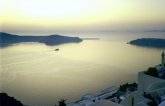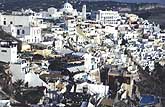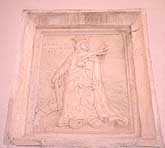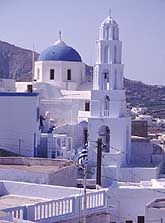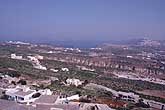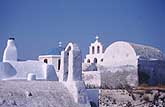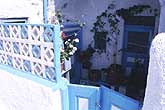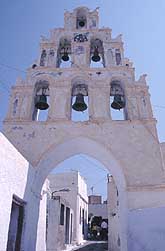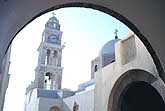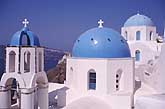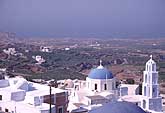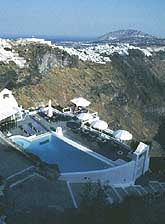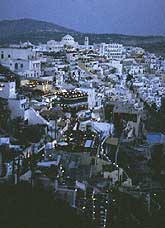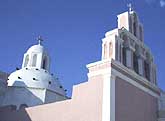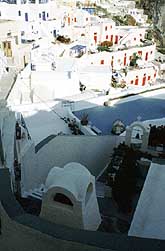| SANTORINI -- HISTORY
Archaeological discoveries suggest that the first appearance of man on the island dates back to the Neolithic Period.
Early Bronze Age. Santorini followed the cultural evolution which took place in the rest of Cyclades Islands. Marble vases , pottery and marble figurines have been
found. All these find belong to the Early Cycladic civilization.
Middle Bronze Age. Santorini entered the so-called Middle Cycladic civilization. An important ancient city seems to have existed at the south of the island near Akrotiri. The close relations with Crete are proved by the influence on the pottery and painting which were found by archaeologists.
About 1550 BC. It is believed that the island Strongyle (rounded), was shattered and its remaining fragments constituted Thera, Therasia and Aspronisi. Tidal waves washed the shores of the surrounding islands and Crete. The eruption is estimated to have been four times more powerful than that of Krakatoa in 1883. Its repercussions within the Aegean area were
terrific. The sinking of Strongyle is frequently identified with the submergence of the mythical Atlantis. Earthquakes destroyed everything. Upon the ruins was founded the Late Minoan City of Acrotiri, a new urban society. One or more rooms in each house were decorated with wall-paintings featuring naturalistic landscapes or animals or humans. This city is now coming to light and promises to greatly extend archeological knowledge. The lay-out of the city resembles the present-day villages of Santorini. One can visit the Ancient
city of Acrotiri and walk through its streets.
About 1500 BC. At Akrotiri a society existed which can be characterized as urban. It seems that this society was a mixture of Cretans (Minoans) and local Cycladic people.
About 1450 BC. Eruption of the volcano.
Abt 1330 BC. According to Herodotos, Phoenicians came and settled in Kalliste. They stayed there for five generations. This information has been neither verified nor rejected by archaeologists.
About 1115 BC. The island became a Lacedaemonian colony. It was completely isolated from the outside world and entered a long "dark age". By that time the island was named Thera after Theras.
Abt 825 BC. The Phoenician alphabet was imported to Thera, Milos and Crete and so the Hellenic language acquired its alphabet.
Archaic period (7th and 6th centuries BC). Thera was in close contact with Crete, Paros, Attica, Corinth, Rhodes and Ionia. The relations were rather superficial. The conservative
Therian society was not easily influenced. The fertile soil covered the needs of the local people who avoided maritime adventures. As a result the Classical period of ancient Hellas did not leave any
particular characteristics in Thera.
Hellinistic period (300-145 BC). The island's strategic position was especially esteemed by the Ptolemies. Thus, Thera became an important naval base from which the successors of Alexander the Great launched their campaigns for dominion over the Aegean.
197 BC. Eruption of the volcano.
19 AD. Eruption of the volcano.
46 AD. Eruption of the volcano
726 AD. Eruption of the volcano.
1204 AD. The Fourth Crusade created the Latin Empire of the Bosphorus.
1207 AD. The Duchy of Naxos of the Archipelago was founded and assigned to Marco I Sanudo. Thera was ceded as a Barony to Giacomo Barozzi. The administration remained in the hands of five generations of Barozzis until 1296. The Barozzis used to call themselves "Dominatores insularum Santorini et Therasia".
1296 AD. The Byzantine Likarios liberated Santorini along with the islands of Amorgos, Seriphos, Kea, Ios, Siphnos and Pholegandros.. However the newly-won freedom was very short lived and before the year was out the Barozzis had returned to Santorini.
During the next years the history of the island is the history of the rivalries between local lords and the Duke of Naxos or disputes between the latter and the Turks.
1570 or 1573 AD. Eruption of the volcano.
1579-1821 AD. Turkish occupation
1650 AD. Eruption of the volcano (26th Sept - 6 Dec)
1707 AD. Eruption of the volcano (23rd May - 17th Jan 1708)
1821 AD. Santorini is liberated.
1866-1870 AD Eruption of the volcano.
1870 AD. Mamet and Gorceix carried out a trial excavation in Akrotiri where a late Minoan settlement exists.
1899 AD. Robert Zahn carried out minor excavations at the site of Potamos (Akrotiri)
1925 AD 11th Aug - 1926 AD 21st May. Eruption of the volcano
1928 AD. Eruption of the volcano (23rd Jan - 17th Mar)
1939 AD End Aug - 1941 Beg July. Eruption of the volcano
1950 AD. Eruption of the volcano (10th Jan - 2nd Feb)
1967 AD. Professor Marinatos begun excavations at Akrotiri and uncovers a Late Minoan settlement.
by Thomas J. Pagonis
Copyright: Hellenic Electronic Center
Photos by Ian Swindale
| 